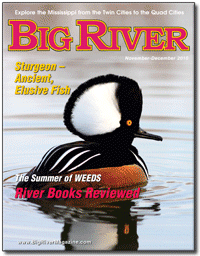Big
River Magazine |
|
 |
|
|
River News Birds in High Water Lush growth of plants in the river this summer should provide ample food supply for migrating waterfowl, and may make them stick around for longer than usual. Migratory birds depend on the river for rest and fuel. Diving ducks, such as canvasbacks, were expected to peak in early November. Last year diving ducks and tundra swans stayed on the Upper Mississippi River Wildlife Refuge for a month, the longest in 10 years. High river levels due to heavy rains and flooding in October affected the distribution of migratory waterfowl on the river. ”It’s a tough year for birds and for hunters,” said FWS wildlife biologist Brian Stemper. Smaller ducks, like teals and wood ducks, that like shallow water didn’t find it in the usual places. They didn’t use the protected closed areas of the Upper Mississippi River Wildlife Refuge as much, said Stemper. Instead, the birds scattered into nontraditional areas — shallowly flooded islands and woods, and even flooded cornfields adjacent to the river. Wild winds and inclement weather grounded some of the weekly aerial waterfowl survey flights on the northern part of the Refuge in October, so Stemper wasn’t sure how the numbers in the north compared with 2009. Flights will continue through November. Check the Refuge website for data showing where the birds are. Migration season was just beginning in the Gulf states, where local refuges are keeping a close eye on the birds as they return to habitat that was directly or indirectly affected by the summer’s giant oil spill. Nutria Tales New Orleans — The damage done to wetlands in Louisiana by nutria, myocastor coypus, one of the biggest invasive species in the country, has dropped as the number of animals trapped has risen, according to a report from a state-and-federal program that offered a $5 bounty on nutria tails since 2002. The 2009-2010 season set a record, with almost a half million tails turned in by Louisiana hunters and trappers. Land loss in Louisiana dropped 90 percent since the program began. The 10-to-20-pound rodents chew off grass roots with their big, orange front teeth, killing the plants and destroying the fabric that holds the marsh together. Then the marsh easily becomes open water. For a while, there was little incentive to trap these animals for their meat or fur. Trappers have not made much from pelts since the 1980s, and before Louisiana chef Philippe Parola started his campaign to introduce Asian carp to the American palate, he unsuccessfully tried the same with nutria. People didn’t really want to eat nutria — some say the large rodent tastes swampy, like bad chicken. Nutria fur is thick and silky, and was once in style, but many trappers just turn in the tail and leave the rest of the body to decompose in the swamp. All these dead critters give high-fashion fur designers a green light — fur lovers can wear nutria and be environmentally fashionable. Last year, New Orleans author and designer Cree McCree started a nonprofit Righteous Fur collective with the benefit of an estuary-program grant. The collective supplies sample furs to designers and sponsors Nutria-palooza! runway shows. Its motto is “Save our Wetlands, Wear More Nutria.” Men’s fashion designer Billy Reid, who hails from nutria-rich Alabama, puts nutria on cuffs, collars and hats. “I love the masculinity of it. It’s sort of the bad-ass fur.” (Times Picayune, 9-26-10; NY Daily News, 4-28-10; Gambit, 3-1-10) Giant Beaver St. Paul — Inspired by beaver engineering at several cleanup sites on the Mississippi and Minnesota rivers, artists Chip Addington and Caylon Hackwith created a sculpture to honor these energetic, industrious animals and pay tribute to cleanup volunteers. Using trash from the rivers, they created a giant beaver for the Minnesota Department or Natural Resource’s “Adopt-A-River” display at the Minnesota State Fair. A split tire serves as the beaver’s tail, pieces of glass bottles and softballs make up the eyes, and a ceramic vase became the critter’s iconic teeth. Now that the fair is over, the artists will decide the fate of the giant beaver. They are considering two public sites. As of late October it was still at the fairgrounds. “It hasn’t flinched,” said the DNR’s Paul Nordell. “It only weighs a half ton. It’s light and portable, compared to the giant pig and other sculptures from past years.” Nordell said the DNR has staged similar displays every year since 1996. To see past entries, check the DNR website. To read more news stories, order this issue or check out one of these retail outlets. |
